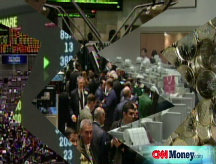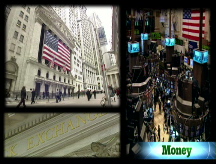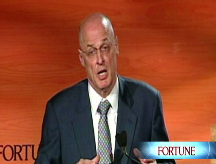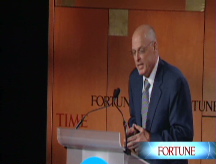Credit market pressure eases
European central banks expected to lower key interest rates to spur lending. Treasurys rally and yields remain near record lows.
NEW YORK (CNNMoney.com) -- The credit market showed modest signs of improvement Tuesday as lending rates eased and investors anticipate European central banks will lower key lending rates this week, making borrowing cheaper in that region.
The credit market is "healing," but banks are still hesitant to lend freely to each other, said William Larkin, portfolio manager at Cabot Money Management.
The 3-month Libor rate edged lower to 2.21% Tuesday from 2.22%, according to Bloomberg.com. The overnight Libor rate slipped to 1% from 1.09%.
Libor, the London Interbank Offered Rate, is a daily average of what 16 different banks charge other banks to lend money in London and is used to calculate adjustable rate mortgages. More than $350 trillion in assets are tied to Libor.
Treasury prices were flat to slightly higher, but the yield on the 10-year note remained at a record low level as investors shied away from volatility on Wall Street.
"The low rates on Treasury bills and the Treasury market in general is a sign of fear that is inherent in the marketplace - it is that flight to quality trade," said Kenneth Naehu, managing director and head of fixed income at Bel Air Investment Advisors.
"Until you start to see some of that fear abate, I don't think that you can have a sustained recovery," added Naehu.
Banks hesitate: Banks are trying to determine where their counterparts sit financially and how healthy their balance sheets are, said Larkin.
And there is heightened concern that some commercial real estate, consumer loans and/or credit card loans "could go bad as the economy decelerates," he said.
The Government Accountability Office will provide Congress with an official review of the progress of the government's $700 billion bailout Tuesday afternoon. Some banks have been criticized for not using government funds to increase lending, but instead to scoop up other banks.
European central banks: While the U.S. government slashed interest rates in the last few months in an effort to unclog frozen lines of credit, European central banks have been more cautious in reducing lending rates.
The European Central Bank and the Bank of England are expected to lower their key lending rates when they make monetary policy announcements later in the week.
"They have been slow to address the economic downturn, where we have been a little bit proactive," said Larkin. He said that when the ECB and the Bank of England lower key interest rates, that should work to spur lending in the regions.
Credit market gauges: While Libor rates and market gauges have not moved dramatically on a daily basis, bank-to-bank lending rates have come down significantly from mid-September, when Lehman Brothers failed and bank-to-bank lending came to a virtual standstill.
"I think a lot of [the easing] has to do with the perceived success of the government's plan to infuse capital into the banking system," said Naehu.
The 3-month Libor rate hit a high of 4.82% on Oct. 10, but coordinated efforts by central banks across the globe to inject liquidity into the economy helped bring those rates down. The 3-month Libor dipped as low as 2.13% on Nov. 12.
The overnight Libor rate has plummeted from its record high of 6.88%, when the credit crisis was at its worst. Since then, the rate has dropped as low as 0.32% on Nov. 5.
Two gauges of market sentiment were little changed, but continued to show small signs of increased confidence in the credit markets.
The "TED spread" eased to 2.14 percentage points from 2.19 late Monday. The TED spread measures the difference between the 3-month Libor and the 3-month Treasury bill, and is a key indicator of risk. The higher the spread, the more unwilling investors are to take risks.
Another indicator, the Libor-OIS spread, edged lower to 1.82 percentage points from 1.83 percentage points. The Libor-OIS spread measures how much cash is available for lending between banks, and is used for determining lending rates. The bigger the spread, the less cash is available for lending.
Treasurys: Government debt prices were mixed Tuesday as the stock market rallied but yields remained at very low levels.
Bond prices and yields move in opposite directions. Treasurys are perceived as one of the safest places for investors to keep their assets in times of economic uncertainty and higher prices signal a flight to that safety.
The yield on the benchmark 10-year note fell to 2.68% from 2.74% late Monday, as the price rose 15/32 to 109-9/32. Last week, the 10-year yield fell below 3% for the first time since the note was first issued in 1962.
Larkin said the tremendous volatility in the stock market has kept downward pressure on Treasury yields.
"There is a big psychological component to this. It does not make sense to be locking in at under 3% for a 10-year," said Larkin. "It is illogical but if you take into consideration the volatility in the stock market, it makes a lot of sense."
Larkin added that as investors watch their assets get "whipsawed," they prefer to keep their funds safe, even if they are not guaranteed a high return.
The 30-year bond rose 22/32 to 124-30/32 and its yield fell to an all-time low of 3.19% from 3.22%.
The 2-year note was little changed at 100-22/32 and its yield was 0.99%.
The yield on the 3-month note rose to 0.04% from 0.03% late Monday. The bill is closely watched as an indicator of investor confidence. Investors and money-market funds shuffle funds in and out of the 3-month bill frequently, as they assess risk in the rest of the marketplace. A higher yield indicates that investors are slightly more optimistic.
The government has been selling an increased amount of government debt to finance the pricey rescue of the financial system. The Treasury auctioned $36 billion worth of 29-day bills Tuesday. ![]()






